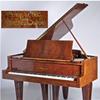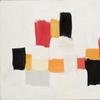Huntington Acquisitions Reunite Panels of Renaissance Altarpiece
- SAN MARINO, California
- /
- May 01, 2018
The Art Collectors’ Council of The Huntington Library, Art Collections, and Botanical Gardens, in San Marino, Calif., has purchased two panel paintings by Italian Renaissance master Cosimo Rosselli (1439–1507). Saint Ansanus and Saint Anthony Abbot, made in about 1470, originally formed the lower third of an altarpiece, the centerpiece of which was The Huntington’s own Madonna and Child in Glory, one of the core works in its Renaissance paintings collection.
Later this year, the panels will be reunited with the Madonna in the Huntington Art Gallery, among Rogier van der Weyden’s Virgin and Child and Domenico Ghirlandaio’s pair of portraits of a man and woman. All of these works, along with the Rosselli Madonna, were acquired by Arabella Huntington, wife of Huntington founder Henry Edwards Huntington, in the early 20th century for her lavish Fifth Avenue apartment. The new acquisitions were purchased by the Art Collectors’ Council at its annual meeting held in late April.
“The opportunity to reunite panels of an altarpiece is exceedingly rare,” said Catherine Hess, chief curator of European art and interim director of the art collections. “To bring together particularly ravishing works of fine condition, documented provenance, and importance to the history of collecting in America, is rarer still.”
An art dealer likely cut down the original Rosselli altarpiece into parts in the late 18th century to produce individual panels that could be sold more profitably, a common practice at the time, according to Hess. The altarpiece originally was made up of seven paintings—one is now in the Czech Republic’s National Gallery in Prague; two are in private collections; and one’s whereabouts are unknown. The altarpiece was reassembled (without the missing panel) in 2001 at the Cornell Art Museum in Florida.
Cosimo Rosselli, a Quattrocento artist active mainly in his native Florence was known for specializing in a brilliant palette. His early work displays the influence of the highly decorative “Gothic International” style of Alessio Baldovinetti and Benozzo Gozzoli. Rosselli had a long and successful career, culminating in the project to create wall frescoes for the Sistine Chapel. According to biographer Giorgio Vasari, Pope Sixtus IV awarded him the prize for the best work in the fresco series, beating out the renowned Botticelli, Ghirlandaio, and Perugino.
Saint Ansanus
Saint Ansanus (284-304 AD), also known as “the Baptizer,” is patron saint of Siena. Tradition states that he became a Christian at the age of 12 and began a missionary apostolate in Siena but was persecuted, arrested, and eventually beheaded around the age of 20. Rosselli rendered him as a young and handsome man kneeling on a small raft-like cloud. The saint uses his right hand to make the Christian “sign of the cross.” The object in his left hand is an unguent box, which held oil for baptismal anointing. On his left shoulder leans the so-called banner of the Resurrection—displaying a red cross on white ground—that refers to Emperor Constantine’s holy vision before a battle of such a cross in the sky with the words, In Hoc Signo Vinces or “with this sign, you shall win.” Constantine did win the battle and he did convert to Christianity, paving the way for the religion to dominate not only the Roman Empire, but also, ultimately, all of Europe.
“Rosselli’s young Ansanus is truly a beautiful figure,” said Hess. “His clear face framed by curls recalls some of Leonardo’s angels, which date to just this moment in the 1470s.” Ansanus wears a fur-lined, bright orange tabard over a red shirt. “The juxtaposition of complementary hues—brilliant orange and sky blue—is particularly vivid.”
Saint Anthony Abbot
Saint Anthony was an Egyptian monk, considered one of the first to retire to the desert for solitary meditation and self-mortification. While Ansanus appears as a fresh and handsome youth, the aged Anthony, who is said to have lived until the age of 105, reveals signs of his hermitage in the desert: a long gray beard and lined and darkened skin. The letter “T” on his left shoulder refers to the way Egyptians represented the cross of Christ in Anthony’s time.
“Both figures are linked by their similarly fervent, adoring gazes,” said Hess. “Using a sophisticated conceit, Rosselli presents the figures paired as complementary mirrored images. While Ansanus appears as a fresh and handsome youth, the aged Anthony reveals the signs of deprivation from years of desert isolation.”
Also acquired by the Art Collectors’ Council
The Huntington’s Art Collectors’ Council also acquired The Open Sea, an 1865 watercolor by British Pre-Raphaelite artist John Brett (1831–1902). “A delicate vision of water and air, The Open Sea displays the artist’s skill at manipulating materials, as well as his deep knowledge of the ocean,” said Melinda McCurdy, associate curator of British art. The watercolor was painted when Brett owned a yacht and spent the winter on the Isle of Wight painting outdoors. The Open Sea attests to his almost forensic powers of observation. “He had a sailor’s appreciation of wind and water, a scientist’s understanding of weather, and an artist’s ability to depict them,” said McCurdy. The Open Sea provided the prototype for two large seascapes Brett painted in succeeding years. The Huntington already holds three pen and ink portraits by Brett.

270x400_c.jpg)


















